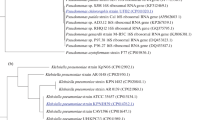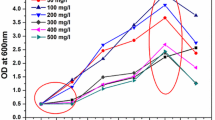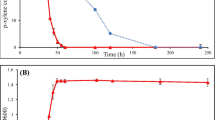Abstract
To examine the trichloroethylene (C2HCl3)-degrading capability of five microorganisms, the maximum rate, extent, and degree of C2HCl3 mineralization were evaluated for Pseudomonas cepacia G4, Pseudomonas cepacia G4 PR1, Pseudomonas mendocina KR1, Pseudomonas putida F1, and Methylosinus trichosporium OB3b using growth conditions commonly reported in the literature for expression of oxygenases responsible for C2HCl3 degradation. By varying the C2HCl3 concentration from 5 μM to 75 μM, Vmax and Km values for C2HCl3 degradation were calculated as 9 nmol/(min mg protein) and 4 μM for P. cepacia G4, 18 nmol/(min mg protein) and 29 μM for P. cepacia G4 PR1, 20 nmol/(min mg protein) and 10 μM for P. mendocina KR1, and 8 nmol/(min mg protein) and 5 μM for P. putida F1. This is the first report of these Michaelis-Menten parameters for P. mendocina KR1, P. putida F1, and P. cepacia G4 PR1. At 75 μM, the extent of C2HCl3 that was degraded after 6 h of incubation with resting cells was 61%–98%; the highest degradation being achieved by toluene-induced P. mendocina KR1. The extent of C2HCl3 mineralization in 6 h (as indicated by concentration of chloride ion) was also measured and varied from 36% for toluene-induced P. putida F1 to 102% for M. trichosporium OB3b. Since C2HCl3 degradation requires new bio-mass, the specific growth rate (μmax) of each of the C2HCl3-degradation microorganisms was determined and varied from 0.080/h (M. trichosporium OB3b) to 0.864/h (P. cepacia G4 PR1).
Similar content being viewed by others
References
Brusseau GA, Tsien H-C, Hanson RS, Wackett LP (1990) Optimization of trichloroethylene oxidation by methanotrophs and the use of a colorimetric assay to detect soluble methane mono-oxygenase activity. Biodegradation 1: 19–29
Duetz WA, Jong CD, Williams PA, Andel JGV (1994) Competition in chemostat culture between Pseudomonas strains that use different pathways for the degradation of toluene. Appl Environ Microbiol 60: 2858–2863
Ensley BD, Kurisko PR (1994) A gas lift bioreactor for vapor-phase destruction of chlorinated organics. Appl Envion Microbiol 60: 285–290
Folsom BR, Chapman PJ (1991) Performance characterization of model bioreactor for the biodegradation of trichloroethylene by Pseudomonas cepacia G4. Appl Environ Microbiol 57: 1602–1608
Folsom BR, Chapman PJ, Pritchard PH (1990) Phenol and trichloroethylene degradation by Psuedomonas cepacia G4: kinetics and interactions between substrates. Appl Environ Microbiol 56: 1279–1285
Fox BG, Borneman JG, Wackett LP, Lipscomb JD (1990) Haloalkene oxidation by the soluble methane monooxygenase from Methylosinus trichosporium OB3b: mechanistic and environmental implications. Biochemistry 29: 6419–6427
Green J, Dalton H (1989) Substrate specificity of soluble methane monoxygenase. J Biol Chem 264: 17698–17703
Jahng D, Wood TK (1994) Trichloroethylene and chloroform degradation by a recombinant pseudomonad expressing soluble methane monooxygenase from Methylosinus trichosporium OB3b. Appl Environ Microbiol 55: 2819–2826
Janssen DB, Scheper A, Dijkhuizen L, Witholt B (1985) Degradation of halogenated aliphatic compounds by Xanthobacter autotrophicus GJ10. Appl Environ Microbiol 49: 673–677
Krumme ML, Timmis KN, Dwyer DF (1993) Degradation of trichloroethylene by Pseudomonas cepacia G4 and the constitutive mutant strain G4 5223 PR1 in aquifer microcosms. Appl Environ Microbiol 59: 2746–2749
Little CD, Palumbo AV, Herbes SE, Lidstrom ME, Tyndall RL, Gilmer PJ (1988) Trichloroethylene biodegradation by a methane-oxidizing bacterium. Appl Environ Microbiol 54: 951–956
Maniatis T, Fritsch EF, Sambrook J (1982) In: Molecular cloning: a laboratory manual. Cold Spring Harbor Laboratory, Cold Spring Harbor, NY
McFarland MJ, Vogel CM, Spain JC (1992) Methanotrophic cometabolism of trichloroethylene (TCE) in a two stage bioreactor system. Water Res 26: 259–265
Nelson M, Montgomery S, Mahaffey W, Pritchard PH (1987) Biodegradation of trichloroethylene and involvement of an aromatic biodegradative pathway. Appl Environ Microbiol 53: 949–954
Oldenhuis R, Vink RLJM, Janssen DB, Witholt B (1989) Degradation of chlorinated aliphatic hydrocarbons by Methylosinus trichosporium OB3b expressing soluble methane monooxygenase. Appl Environ Microbiol 55: 2819–2826
Oldenhuis R, Oedzes JY, Waarde JJVD, Janssen DB (1991) Kinetics of chlorinated hydrocarbon degradation by Methylosinus trichosporium OB3b and toxicity of trichloroethylene. Appl Environ Microbiol 57: 7–14
Park S, Hanna ML, Taylor RT, Droege MW (1991) Batch cultivation of Methylosinus trichosporium OB3b. I. Production of soluble methane monooxygenase. Biotechnol Bioeng 38: 423–433
Phelps PA, Agarwal SK, Speitel GE, Georgiou G (1992) Methylosinus trichosporium OB3b mutants having constitutive expression of soluble methane monooxygenase in the presence of high levels of copper. Appl Environ Microbiol 58: 3701–3708
Rasche ME, Hyman MR, Arp DJ (1991) Factors limiting aliphatic chlorocarbon degradation by Nitrosomonas europaea: cometabolic inactivation of ammonia monooxygenase and substrate specificity. Appl Environ Microbiol 57: 2986–2994
Shields MS, Reagin MJ (1992) Selection of a Pseudomonas cepacia strain constitutive for the degradation of trichloroethylene. Appl Environ Microbiol 58: 3977–3983
Shields MS, Montgomery SO, Chapman PJ, Cuskey SM, Pritchard PH (1989) Novel pathway of toluene catabolism in trichloroethylene-degrading bacterium G4. Appl Environ Microbiol 55: 1624–1629
Shields MS, Reagin MJ, Gerger RR, Somerville C, Schaubhut R, Campbell R, Hu-Primmer J (1994) Constitutive degradation of trichloroethylene by an altered bacterium in a gas-phase bioreactor. In: Hinchee RE, Leeson A, Semprini L, Ong SK (eds) Bioremediation of chlorinated and polycyclic aromatic hydrocarbon compounds. Lewis, Boca, Raton, Fla, pp 50–65
Tsien HC, Brusseau GA, Hanson RS, Wackett LP (1989) Biodegradation of trichloroethylene by Methylosinus trichosporium OB3b. Appl Environ Microbiol 55: 3155–3161
Uchiyama H, Nakajima T, Yagi O, Nakahara T (1992) Role of heterotrophic bacteria in complete mineralization of trichloroethylene by Methylocystis sp. Strain M. Appl Environ Microbiol 58: 3067–3071
US EPA (1984). Hazardous waste sites: descriptions of sites on current national priorities list, October 1984. United States Environmental Protection Agency, Washington, DC
Vannelli T, Logan M, Arciero DM, Hooper AB (1990) Degradation of halogenated aliphatic compounds by the ammonia-oxidizing bacterium Nitrosomonas europaea. Appl Environ Microbiol 56: 1169–1171
Wackett LP, Gibson DT (1988) Degradation of trichloroethylene by toluene dioxygenase in whole-cell studies with Pseudomonas putida F1. Appl Environ Microbiol 54: 1703–1708
Wackett LP, Householder SR (1989) Toxicity of trichloroethylene to Pseudomonas putida F1 is mediated by toluene dioxygenase. Appl Environ Microbiol 55: 2723–2725
Wackett LP, Brusseau GA, Householder SR, Hanson RS (1989) Survey of microbial oxygenases: Trichloroethylene degradation of propane-oxidizing bacteria. Appl Environ Microbiol 55: 2960–2964
Wackett LP, Sadowsky MJ, Newman LM, Hur H-G, Li S (1994) Metabolism of polyhalogenated compounds by a genetically engineered bacterium, Nature 368: 627–629
Winter RB, Yen K-M, Ensley BD (1989) Efficient degradation of trichloroethylene by a recombinant Escherichia coli. Biotechnology 7: 282–285
Yen K-M, Karl MR, Blatt LM, Simon MJ, Winter RB, Fausset PR, Lu HS, Harcourt AA, Chen KK (1991) Cloning and characterization of a Pseudomonas mendocina KR1 gene cluster encoding toluene-4-monooxygenase, J Bacteriol 173: 5315–5327
Zylstra GJ, McCombie WR, Gibson DT, Finette BA (1988) Toluene degradation by Pseudomanas putida F1: genetic organization of the tod operon. Appl Environ Microbiol 54: 1498–1503
Zylstra GJ, Wackett LP, Gibson DT (1989) Trichloroethylene degradation by Escherichia coli containing the cloned Pseudomonas putida F1 toluene dioxygenase genes. Appl Environ Microbiol 55: 3162–3166
Author information
Authors and Affiliations
Rights and permissions
About this article
Cite this article
Sun, A.K., Wood, T.K. Trichloroethylene degradation and mineralization by pseudomonads and Methylosinus trichosporium OB3b. Appl Microbiol Biotechnol 45, 248–256 (1996). https://doi.org/10.1007/s002530050679
Received:
Revised:
Accepted:
Issue Date:
DOI: https://doi.org/10.1007/s002530050679




